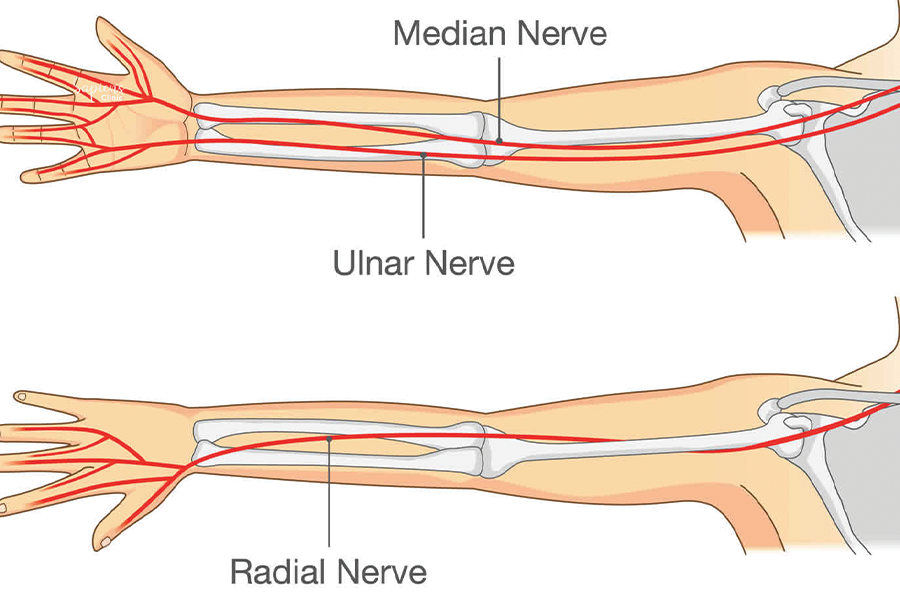Radial, Ulnar and Median Nerve Palsy Treatment in Malleshwaram
Nerve palsies affecting the radial, ulnar, and median nerves can significantly impair hand and arm function, leading to challenges in daily activities. At Sapiens Clinic in Malleshwaram, we specialize in diagnosing and treating these conditions, aiming to restore mobility, reduce pain, and enhance quality of life.
Understanding Nerve Palsies
The radial, ulnar, and median nerves are crucial for motor and sensory functions in the upper limb. Damage or compression to these nerves can result in palsies, characterized by muscle weakness, loss of sensation, or both.
Causes and Risk Factors
Nerve palsies can arise from various factors :
- Radial Nerve Palsy: Often due to humeral fractures, prolonged compression (e.g., “Saturday night palsy”), or improper use of crutches.
- Ulnar Nerve Palsy: Commonly results from cubital tunnel syndrome, where the ulnar nerve is compressed at the elbow.
- Median Nerve Palsy: Typically associated with carpal tunnel syndrome, caused by pressure on the median nerve at the wrist.
Risk factors include repetitive motions, trauma, anatomical variations, and certain medical conditions like diabetes.
Symptoms
Symptoms vary depending on the affected nerve:
- Radial Nerve Palsy: Wrist drop, inability to extend the wrist and fingers, and numbness on the back of the hand.
- Ulnar Nerve Palsy: Numbness and tingling in the ring and little fingers, hand weakness, and muscle wasting in severe cases.
- Median Nerve Palsy: Numbness and tingling in the thumb, index, middle, and part of the ring finger; weakness in thumb opposition.
Early recognition of these symptoms is crucial for effective management.
Diagnosis
Accurate diagnosis involves :
- Clinical Evaluation: Assessing medical history and physical examination.
- Electrodiagnostic Tests: EMG and nerve conduction studies to evaluate nerve function.
- Imaging Studies: MRI or ultrasound to visualize nerve structures and identify compression points.
These assessments help determine the extent and location of nerve involvement.
Treatment Options
Management strategies are tailored based on the specific condition :
- Conservative Therapies:
- Physical Therapy: Exercises to maintain joint mobility and muscle strength.
- Occupational Therapy: Training to perform daily activities safely.
- Medications: Pain relievers or anti-inflammatory drugs.
- Splinting: Immobilization to prevent further nerve irritation.
- Surgical Interventions:
- Nerve Decompression: Relieving pressure on compressed nerves.
- Nerve Repair or Grafting: Reconnecting or replacing damaged nerve segments.
- Tendon Transfers: Redirecting tendons to restore function.
Early intervention often leads to better outcomes.
Recovery and Rehabilitation
Post-treatment rehabilitation focuses on :
- Restoring Function: Through targeted exercises and therapies.
- Pain Management: Utilizing medications and therapeutic modalities.
- Monitoring Progress: Regular follow-ups to assess recovery and adjust treatment plans.
Recovery timelines vary based on the severity of the injury and the treatment approach.
Conclusion
Radial, ulnar and median nerve palsies can significantly impact daily activities and overall well-being. At Sapiens Clinic, Malleshwaram, our multidisciplinary team is dedicated to providing comprehensive care, from accurate diagnosis to personalized treatment plans, ensuring optimal recovery and prevention of future injuries.
FAQs
1. What are common signs of nerve palsy in the hand?
Symptoms include numbness, tingling, weakness, and pain in the hand or fingers.
2. Can nerve palsies heal without surgery?
Some mild nerve injuries may recover with conservative treatments, but severe cases often require surgical intervention.
3. How long does recovery take after nerve surgery?
Recovery varies but can range from several weeks to months, depending on the injury’s severity and the individual’s response to rehabilitation.
4. Are there risks associated with nerve surgery?
As with any surgery, risks include infection, bleeding, and incomplete recovery; however, benefits often outweigh risks in severe cases.
5. How can I prevent nerve palsies in the hand and arm?
Maintaining proper ergonomics, taking regular breaks during repetitive tasks, and avoiding prolonged pressure on nerves can help prevent injuries.

Leave a Reply